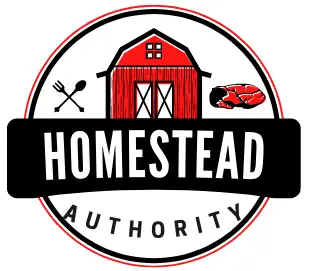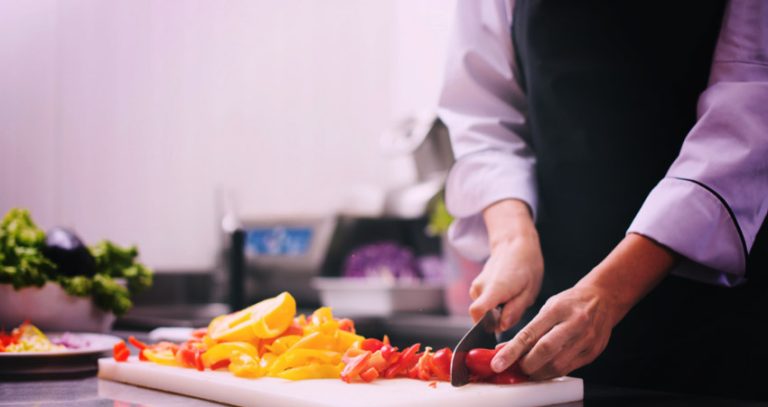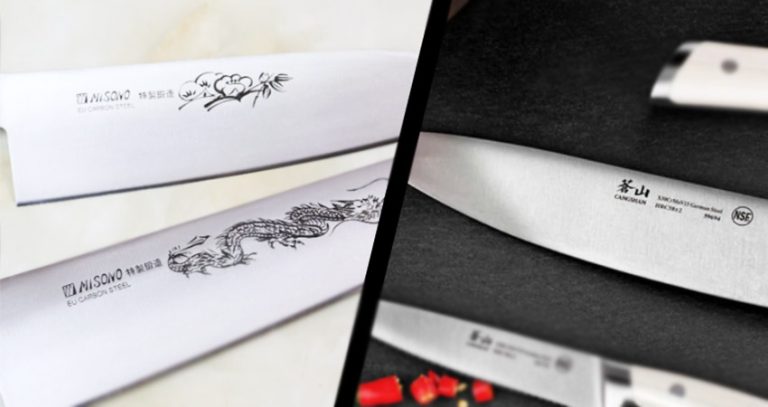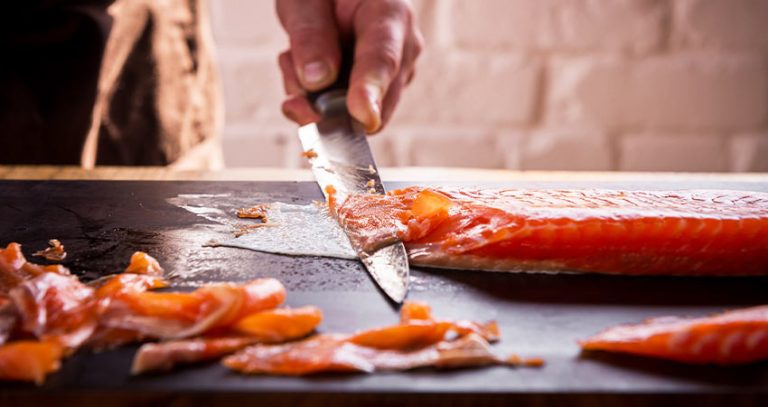Should I Get A Santoku Knife Or A Chef Knife?
Whether you’re a professional chef or a cookery enthusiast, the kind of knife you choose can make a huge difference. You can choose between a Santoku knife, Chef knife, or both.
The Santoku knife and the Chef knife have significant differences, making them work differently. Knowing the differences between these knives can help you pick only the best.
The Santoku knife is suitable for chopping, mincing, slicing, and other types of fine chopping.
On the other hand, the Chef knife is excellent for deboning meat and cutting tougher fruits and vegetables like watermelons and pumpkins.
This article discusses knives in greater detail to help you pick only the best. Keep reading for more information.
Santoku Knife: What Is It Used For?

Santoku knife is a multi-use kitchen tool suitable for chopping, mincing, and slicing. Its blade has three main parts –
- The cutting edge
- The heel
- The tip
For slicing, the leading cutting edge works wonders.
If you want to chop intensely, the heel is perfect. Finally, the tip is excellent for detailed work. It is a general-purpose knife that can cut fish, meat, and vegetables.
It is small-sized and lighter. The Santoku knife’s blade is between six and seven inches long. It is shaped differently from the Chef’s knife thanks to its shorter, wider blade, curved tip, and flatter cutting edge.
Using a Santoku knife involves an up-and-down chopping motion. You have to lift the blade off and back to the chopping board as you keep cutting.
Chef Knife: What Is It Used For?

The Chef knife’s blade is straight-edged, with the section between the heel and the tip slightly curved. Its blade measures eight to twelve inches from heel to
Tip. The cutting edge features the ‘belly’ – a generous curve that makes it easier to use rocking motions. It is, therefore, perfect for the rock-chop motion.
Apart from chopping ingredients, the knife’s heavy-duty blade can serve other cutting tasks such as quickly cutting through thick meat slabs and heavy fruits and vegetables like melons and squashes.
On the other hand, the pointed tip is perfect for trimming fat, scoring meat, and other detailed work. The blade’s flat edge is perfect for gently crushing ingredients such as garlic.
Santoku Knife Vs. Chef Knife: A Brief Comparison?
While Santoku and Chef knives serve nearly similar purposes, one is more precise. That’s mainly because of how the knives are crafted.
The following are the main differences between a Santoku knife and a Chef knife:
1. Style And Performance

Santoku knives can be sharpened on one or two sides of the blade. Traditionally, the knife is sharped on one side.
With that, you can control the direction of cutting. With a pull-through or traditional steel sharpener, those sharpened on two sides are easier to maintain.
The Santoku knife has a narrow blade suitable for making thinner cuts.
The straight-edged, slightly-curved chef knife is robust and multi-purpose. It is a thin, flexible blade and a pointed tip.
The Chef knife is resilient, unlike the Santoku knife, which has a rigid blade that can easily chip. It can debone the meat and cut butternut squash and other tough vegetables.
2. Blade Length

Santoku knives have a blade length of about six inches. Its blade is much shorter than the Chef knife, which is between eight and fourteen inches.
With the shorter blade of the Santoku knife, you have more control over the cutting process. The blades of Chef knives are heavier, making them robust all-rounders.
3. Blade Material

The blade material and finish for any knife depend on the manufacturer. In the case of the Santoku knife, its blade is made from V-Gold-10-series produced in Japan.
The high carbon steel is strong and resists corrosion like stainless steel. Since the blades are strong, they require less frequent sharpening.
On the other hand, the Chef knife is made from a softer, tougher, and thicker stainless-steel blade.
Since the blade is a softer steel, it requires more frequent sharpening. The blade is less likely to chip off but may feel a little too heavy.
However, cleaning a Chef knife requires the use of less abrasive materials.
4. The Handle

A typical Santoku knife has no bolster on the handle. That’s contrary to the chef knife, especially which has a bolster. The handle for the Santoku knife starts immediately after the blade.
A bolster provides more grip and protects the hand from slipping and getting hurt by the sharp blade. However, both knives have a full tang handle offering a balanced feel when handled.
Should I Get A Santoku Knife Or A Chef Knife?
You could be asking the question: should I get a Santoku knife or Chef knife? You should consider several things before settling on one type of knife or the other.
You may want to look at the following:
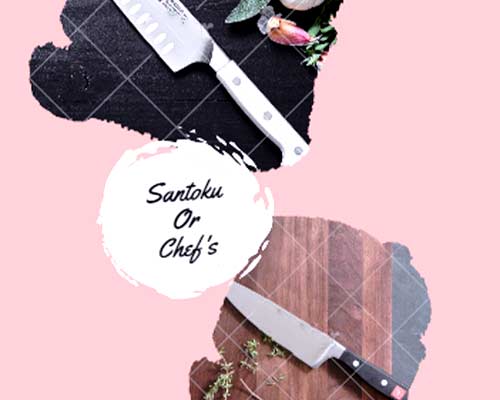
- The Grip
Essentially, you should choose a knife that’s perfect for gripping. Concerning the grip, both the Santoku knife and Chef knife have full tang handles and are easy to grip.
Pick the Santoku knife if you have no problem gripping the handle without the bolster. Otherwise, you can choose the Chef knife.
- Cooking Style
The type of knife you pick depends on what and how you cook.
For example, if you mainly cook vegetables, fruit, and fish with little or no meat, the Santoku knife is a perfect choice. The Santoku blade can make fine chops of ingredients around the kitchen.
On the other hand, the Chef knife is a robust all-rounder that can debone the meat and cut tough fruits like pumpkins into smaller pieces. It is one of the multi-purpose kitchen knives that can make significant cuts.
If you cook different dishes, having both knives would be the best option.
- Longevity of Sharpened Edge
The Santoku knife has a tough high-carbon-steel blade with a more permanent sharpened edge. You can use it for a long time without sharpening it often.
On the other hand, the Chef knife is a softer stainless-steel material, which may get blunt quickly.
For that reason, you may need to sharpen it more often. Depending on how ready you are to sharpen it, you can choose either one of the other.
- Safety
One of the things you might not like about the Santoku knife is the lack of a bolster. Your hand can easily slip to the blade and get hurt.
On the other hand, the Chef knife has a bolster, which keeps you safe in the kitchen.
Conclusion
Given the differences between the Santoku knife and the Chef knife, it is clear the two are great additions to any kitchen.
While the Santoku knife is suitable for fine chops, the Chef can best handle meat deboning tasks.
The Santoku knife has a solid carbon-steel blade that stays sharpened for longer but can easily chip.
On the other hand, the Chef knife has a stainless-steel blade that resists stains but requires frequent sharpening.
Both types of knives ate comfortable to handle, even though the bolster on the Chef knife makes it safer to handle.
You can choose either the Santoku knife or the Chef knife, depending on the purpose of using it.
